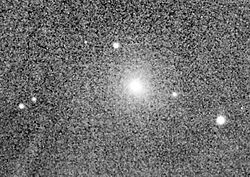 | |
| Discovery | |
|---|---|
| Discovered by | John Grigg and John Francis Skjellerup |
| Discovery date | 1902 and 1922 |
| Designations | |
| Alternative designations | 1808 C1; 1808 III; 1902 O1; 1902 II; 1902c; 1922 K1; 1922 I; 1922b; 1927 F1; 1927 V; 1927e; 1932 II; 1932d; 1937 III; 1937e; 1942 V; 1942d; 1947 II; 1947a; 1952 IV; 1952b; 1957 I; 1956i; 1961 IX; 1961g; 1967 I; 1966f; 1972 II; 1972b; 1977 VI; 1977b; 1982 IV; 1982a; 1987 X; 1986m; 1992 XVIII |
| Orbital characteristics | |
| Epoch | 2023-02-25 (JD 2460000.5) |
| Aphelion | 4.947 AU |
| Perihelion | 1.0840 AU |
| Semi-major axis | 3.015 AU |
| Eccentricity | 0.6405 |
| Orbital period | 5.23 yr |
| Max. orbital speed | 36.6 km/s @ perihelion |
| Inclination | 22.43° |
| Last perihelion | October 1, 2018 July 6, 2013 March 23, 2008 |
| Next perihelion | 2023-Dec-25 |
| Earth MOID | 0.1 AU (15 million km) |
Comet Grigg–Skjellerup (formally designated 26P/Grigg–Skjellerup) is a periodic comet. It was visited by the Giotto probe in July 1992. The spacecraft came as close as 200 km, but could not take pictures because some instruments were damaged from its encounter with Halley's Comet. The comet last came to perihelion (closest approach to the Sun) on 25 December 2023, but was 1.8 AU from Earth and only 31 degrees from the Sun.
History of observation
The comet was discovered in 1902 by John Grigg of New Zealand, and rediscovered in its next appearance in 1922 by John Francis Skjellerup, an Australian then living and working for about two decades in South Africa where he was a founder member of the Astronomical Society of Southern Africa. In 1987, it was belatedly discovered by Ľubor Kresák that the comet had been observed in 1808 as well, by Jean-Louis Pons. Pons observed the comet on 6 and 9 February, which was insufficient to calculate an approximate orbit.
In 1972 the comet was discovered to produce a meteor shower, the Pi Puppids, and its current orbit makes them peak around April 23, for observers in the southern hemisphere, best seen when the comet is near perihelion.
During the comet's 1982 approach it was detected using radar by the Arecibo Observatory.
Having its recent perihelion so close to Earth's orbit made it an easy target to reach for the Giotto spacecraft in 1992, whose primary mission was to Comet Halley. Giotto had a closest approach to Grigg–Skjellerup of 200 km, much closer than its approach to Comet Halley, but was unable to obtain images as its camera was destroyed during the Halley rendezvous in 1986.
The 2002 return (expected perihelion around October 8, 2002) was very unfavorable and no observations were reported.
Properties
The comet has often suffered the gravitational influence of Jupiter, which has altered its orbit considerably. For instance, its perihelion distance has changed from 0.77 AU in 1725 to 0.89 AU in 1922 to 0.99 AU in 1977 and to 1.12 AU in 1999.
The comet nucleus is estimated to be 2.6 kilometers in diameter.
The comet is a type locality for the mineral brownleeite.
Popular culture
- In Neal Stephenson's science fiction novel Seveneves, 26P/Grigg–Skjellerup serves as a potential source of water and rocket propellant for the "Cloud Ark" survivors, and is frequently referred to by the nickname "Greg's Skeleton" by way of homophonic transformation.
References
- ^ "Horizons Batch for 26P/Grigg-Skjellerup (90000375) on 2023-Dec-25" (Perihelion occurs when rdot flips from negative to positive). JPL Horizons. Archived from the original on 2023-02-16. Retrieved 2023-02-11. (JPL#K234/7 Soln.date: 2022-Dec-19)
- ^ "26P/Grigg-Skjellerup Orbit". Minor Planet Center. Retrieved 2014-06-16.
- Syuichi Nakano (2010-04-08). "26P/Grigg-Skjellerup (NK 1908)". OAA Computing and Minor Planet Sections. Retrieved 2012-02-18.
- ^ Kinoshita, Kazuo (2018-07-03). "26P/Grigg-Skjellerup past, present and future orbital elements". Comet Orbit. Archived from the original on 2011-05-20. Retrieved 2023-07-24.
- ^ "JPL Small-Body Database Browser: 26P/Grigg–Skjellerup" (2022-12-15 last obs). Jet Propulsion Laboratory. Retrieved 2020-09-29.
- "Giotto, ESA's first deep-space mission: 25 years ago". European Space Agency. March 11, 2011. Archived from the original on October 17, 2011.
- "Giotto's second comet encounter". European Space Agency. March 10, 2006. Archived from the original on January 19, 2012.
- Kresak, L. (1 March 1987). "The 1808 Apparition and the Long-Term Physical Evolution of Periodic Comet Grigg Skjelierup". Bulletin of the Astronomical Institutes of Czechoslovakia. 38: 65. ISSN 0004-6248.
- Harmon, J.K; Campbell, D.B; Ostro, S.J; Nolan, M.C (1999). "Radar observations of comets" (PDF). Planetary and Space Science. 47 (12): 1409–1422. Bibcode:1999P&SS...47.1409H. doi:10.1016/S0032-0633(99)00068-9. Retrieved 22 November 2020.
- "Comet 26P/Grigg-Skjellerup, Outer Space". www.mindat.org. Archived from the original on May 20, 2017. Retrieved April 3, 2017.
- "NASA Finds New Type of Comet Dust Mineral". www.nasa.gov. June 12, 2008. Retrieved April 3, 2017.
External links
- Orbital simulation from JPL (Java) / Horizons Ephemeris
- 26P/Grigg-Skjellerup – Seiichi Yoshida @ aerith.net
- ESA website about 26P/Grigg–Skjellerup
- Recovery of comet 26P/Grigg–Skjellerup (Remanzacco Observatory : December 26, 2012)
| Numbered comets | ||
|---|---|---|
| Previous 25D/Neujmin |
26P/Grigg–Skjellerup | Next 27P/Crommelin |

